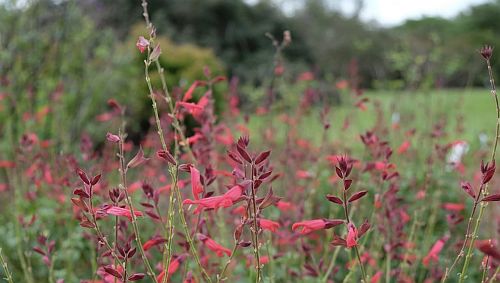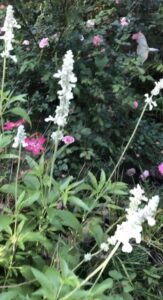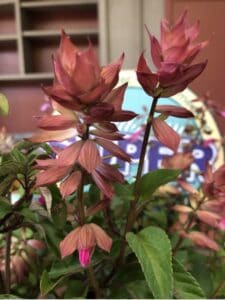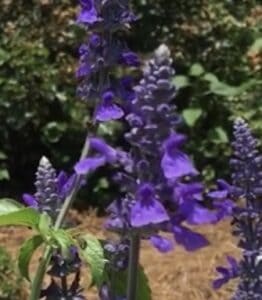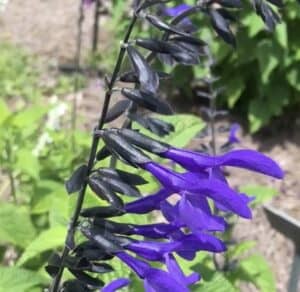(Image above: Roman Red – K. Blackburn)
Summer of Salvias
Salvias are an excellent addition to warm-season landscapes, and with a wide range of colors and sizes available, it was difficult for the LSU AgCenter to decide on a favorite. Therefore, they gave the summer 2022 Louisiana Super Plant title to all the salvias according to Heather Kirk-Ballard, LSU AgCenter Horticulturist. Louisiana Super Plants are university-tested, industry-approved plants that not only are beautiful but also can stand up to Louisiana’s climate. Salvias fit the bill perfectly. The perennial salvias recommended include ‘Roman Red’, ‘Skyscraper Orange’, ‘White Flame’, ‘Mystic Spires Blue Improved’ and ‘Blue Suede Shoes’.
Salvias are the largest member of the sage family, with thousands of species found all over the world. Hundreds of species are native to the Americas. Salvias are herbaceous, flowering plants with both annual and perennial types. They are profuse bloomers and highly attractive to pollinators. Salvia flowers are tall spikes called racemes or panicles and come in bright colors of blue, pink, purple, red and sometimes white and yellow. The flowers are often tubular, or bell shaped, making them attractive to pollinators such as hummingbirds, butterflies and bees. All salvias have high nectar content.
(Images above: [left] White Flame – K. Blackburn; [right] Skyscraper Orange – K. Blackburn)
Salvias perform best when they are planted in full sun and in well-drained soils. They are stunning when used in mass plantings. Salvias also do well in container plantings alone or paired with a spiller. Salvias make great cut flowers and will last for several days in a vase indoors. They make a great addition to pollinator and cottage-themed gardens. Many salvias are drought tolerant once established. They have few pests or disease problems. Fertilize them in early spring with a slow-release granular fertilizer or with a liquid feed a few times during the extended flowering season.
(Image above: Blue Sued Shoes – K. Blackburn)
Salvias come in a wide range of heights and spreads. Most of them reach heights of 2 to 4 feet with the same spread. Space plants at 24 to 36 inches for best growth. Heather recommends putting them in the middle or towards the back of the garden bed. Salvias grow quickly and will provide color and greenery for a full look. Keep them looking tidy into the fall by lightly pruning. Many varieties do not require deadheading, but this will encourage new flowers. Many are perennials and will come back each spring after freezing temperatures. Plants with freeze damage can be trimmed in spring before new growth emerges. Annual salvias are warm-season performers, perennial types will bloom year-round if not killed back by frost or freezes and come back year after year from hardy roots. Salvias often self-propagate; you may find seedlings in other parts of your landscape.
(Images above: [left] Mystic Spires – K. Blackburn; [right] Black and Blue – K. Blackburn)
The LSU AgCenter has recommended some selections based on excellent performance in trials at its Hammond Research Station:
Roman Red has showy, crimson flowers on upright, compact plants. It looks stunning in a mass planting and can be used as a border accent. It prefers drier soils. A native red salvia is scarlet sage, also known as red sage (Salvia coccinea). It attracts hummingbirds and butterflies with its rich red, tubular flowers that appear from spring through fall. It is fairly drought tolerant. White Flame has white flowers on a compact habit with excellent heat performance. It matches Mystic Spires salvia in height. Mystic Spires Blue Improved is a blue salvia in a compact form that produces tons of true-blue flowers. It is heat and humidity tolerant and is “improved” because it sheds its dead petals, keeping a cleaner look. Blue Suede Shoes, a hybrid salvia selection from the ‘Rockin’ series of salvias, has light blue flowers, each with a black calyx. Skyscraper Orange is a vigorous heavy flowering salvia with glossy deep green leaves. Skyscraper Orange is suited to drier soil and performs well in containers also.
These tough plants are heat and drought tolerant. You can find salvias at your local Garden Centers. See LSUagcenter.com for a list of where to find Super Plants.
*(information from article by Heather Kirk-Ballard, LSU AgCenter Horticulturist and LSU AgCenter Hammond Research station)

By Karen Blackburn

